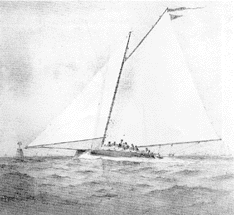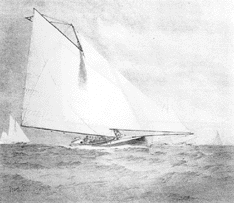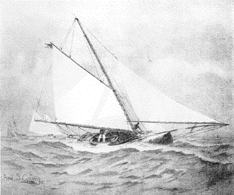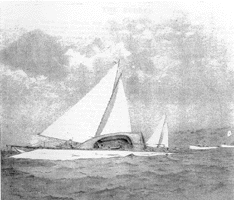 |
Ante-Bellum |
For
PDF file of newspaper clippings on this topic click here |
||
| Many years ago, before the civil war, small boats were avidly raced on the Hudson River at Ossining, then known as the Village of Sing Sing. The boats were called sandbaggers and they sometimes raced for cash prizes. Their owners formed the Sing Sing Yacht Club in 1858. Sing
Sing Yachting in ’58 It may not be uninteresting to our readers
to give a glance back occasionally to time long ago.
On the first day of September, 1858, thirty–seven years ago,
the first annual regatta of the Sing Sing Yacht Club took place.
The route was from the lower dock around the flat boat, stationed
between Teller’s Point and Sneeden’s and thence opposite the residence
of Col. Webb, and thence to the starting point.
The boats entered for the prizes were the Hester Ann, owned
by Nicholas Nearhof of the Point; Nameless, by Stephen T Kipp; Eliza
by DeWitt C Beardsley; Swallow, by Wm. Sniffin; Quaker by Joseph
J Leggett; Imp, Willie Brandreth; Louisa by Wm. Lyon; and Hattie,
by James L Wheeler. The
boats were all sailed by their respective owners, and the prizes
were awarded by Henry L Butler and John Haff, the appointed judges,
as follows: Hester
Ann, first prize …………..$22.50 Postponement. The Regatta of the Sing
Sing Yacht Club, which was to have taken place today, has been postponed
until Saturday next, in consequence of the severe storm. The names of the boats to be entered for the race are the Hester
Ann, Louisa, |
Hattie, Swallow, Imp, Eliza, Quaker and Eagle. They leave the Dock from this place, proceed
to Tarrytown Point, cross to Nyack, and then back to their starting
place. A rich time is anticipated and as usual, the different boats
have their friends, and bets are made as to the winning boat. --September 16, 1858  The Sandbagger The sandbagger is now only a memory but it is a memory full of excitement and not without instruction. The day of the sandbagger was long and crowded with incident. While not well defined in limits, it covered a period of at least thirty-five years, beginning with 1850 and ending with 1885. It reached its fullness in the seventies. Then the waters about New York swarmed with craft that no doubt seemed beautiful at the time but would be pronounced odd by the Herreshoffised taste of the present day. From twenty to forty of them were to be seen in almost every regatta hereabout. Nearly all of the sandbaggers were strongly built. It was essential to build them strong because of the great sail-spread they carried, and properly |
The sandbagger was, bear in mind it no longer is, like some of the so-called flying machines, a thing of small body and great wings. With plumb stem, angular stern, low freeboard, scantling shaped., downward curved bowsprit, a ladder-like outrigger aft, it carried an immense mainsail and jib, and not infrequently, a sprit topsail and jib topsail. It was, without exception, an open boat, varying in length form 16 to 29 feet, and from 8 to 13 feet in breadth. There were some up to 30 feet in length and some under 16 feet, but they did not count. The most successful boats were about 28 feet long and all of the famous racers were within the limits given.The Susie S, for example was 27 feet long and 9 feet broad. According to size they carried from 30 to 90 sandbags, each of 50 |
||
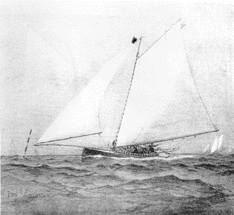 pounds weights, and a crew of from half a dozen to fifteen men. The Dare Devil, of New Rochelle, owned by C Olive Iselin, carried 90 sandbags and was accredited with the largest sail-spread for her inches of any boat afloat. When the boat was on the wind the sandbags were piled up to windward outside the cockpit coaming and the crew, except the skipper and the sheet tenders, piled upon the sandbags. When the boat went about the sandbags and the crew were shifted, which involved some lively hustling. When quick work was not done some sandbags went over board, not infrequently a man or two, and sometimes also, all hands and the skipper. With the single exception of Charlie Barr, all of the famous yacht skippers learned the trick in the sandbagger. Joe Ellsworth, Hank Haff Aubrey Crocker, all first attracted attention as sandbag skippers. But there were others, not destined to become internationally known, even more famous than those, as skippers of this particular craft. The most famous of the company was Capt. Ira Smith, a Fulton ferry pilot, who probably won more races than any two other skippers. Next in rank stood Jake Schmidt, of Staten Island, who distinguished himself as a builder as well as a skipper. Jake has been stowed away in Davy Jones’ locker for some years, but Capt Ira though over 70 years old, is still sitting upon the lid. Other notable skippers were Harry Smedley, likewise a boat builder, Sam Greenwood, Joe Morris, Charlie Thatford and Jim Sweeney. No important regatta was complete without the presence of some or all of these noted skippers, each of whom had a host of admirers ready to back with money their estimate of his skill. No better evidence of the popularity of the sandbagger in its day can be |
than the fact that some of the smallest of them were owned and raced by wealthy men who either then or afterwards were prominent members of the New York Yacht Club. For example, the fourth-class boats Fidget, Flyaway and Victoria were owned respectively by Irving Grinnell, Van Buren Livingston and James A Roosevelt. The recognition of the sandbagger was not therefore confined to yachtsmen of moderate means and obscure associations. They were not very cheap boats for the time. The average cost was about $1,000 and the cost of maintenance, on account of the large crews required was considerable. Vol.
17 (1906) Small Yacht Racing in 1861. The sailboat Comet was built in 1860 and was very different in type from the boats of that time. The boats at that date were plumb at bow and stern, the measurement was length only, and the intention was to get as large a boat for the length as possible. The popular boat was a light clinch-work craft, planked on moulds and the frames bent in after the boat was planked. This, of course, made a very light hull; in fact, lightness of construction was then considered as vital to speed as it is now.
|
midsection and stern. The keel was bent to a curve of about 7 inches, and the tuck of the stern was intended to be about 3 inches below the water, while the bow was not to draw more than 6 inches.There was a rumor that there was a very fast boat up at Sing Sing, built by a “Genius”, who had never learned the trade. This boat rejoiced in the euphonious nomenclature of Hester Ann, and there were men up there who would back their opinion. There was a man from Hoboken who was playfully called the “Clacker. The wily “Clacker” went up to spy out the land and came back full of chuckles, and advised the owner of Comet to shift her mast aft, and put a sloop rig on her, and make a match with the guileless resident of what is now called Ossining.
After a long wrangle, the race was arranged. The scheme put forward by |
||
| the natives was “for the New York boat to start five minutes ahead, then there would be a fair show and no gougin’.” The Yorkers proposed York ways: toss for choice, and the winner start from the windward position. This was a once rated down as unfair. Then followed some drinks and talk, the steersman of Comet taking none of them, a man of displacement representing him in the wrangle. Finally, the boats were taken to a sloop, and just as the time was called, a jealous retainer of “Hester Ann” grabbed the jib sheet of Comet to pull her in closer to the sloop. Comet filled of at once, and the retainer let go the sheet to avoid going overboard, and away went Comet; both boats were called back, and Comet at once returned. Hester Ann refused to come back, and sailed the course over and claimed the stakes. This financial stroke of genius was a once vetoed by their own judge, and it was decided to resail. This time the race was started, and Comet at once took the lead, and turned the first mark far in advance. The first mark was up the river, and then back to the dock. One trouble with Hester Ann was that to make her look nice they had limed the sails, and the lime had drawn them up through the center, and she did not move well. On the way down Comet spun out a lead of nearly three miles, when the wind left her. Away in the distance could be seen Hester Ann coming down before it with a “bone in her teeth”, and she carried the wind nearly to Comet so that the latter turned the lower mark only a short distance ahead, but as soon as the boats were on the wind Comet took command again, and obtained a good lead and kept between Hester Ann and the mark at every tack. At last the wind failed entirely. Comet came to a dead stop; Hester Ann seemed to hold the light air, though the fly would be seen hanging limp and motionless. As one of the rules was worded so that men or ballast could be taken out, we hailed a boat near and let two men out, leaving three in the boat, and emptied the sand out of the bags.
|
Hester Ann slowly came up until she was near enough to see what was done on board, and then stopped. Pies are much sought after for food during races, and the tin plates have been known to be used to propel a boat, but if you are near they can not be utilized. While we lay idly waiting for the wind to come, we saw the clouds across the river making up for a squall. And what would we do with three men in an 18-foot boat with racing sails on. But not much thought was given to this side of it, and arrangements were soon made. The “Clacker” knew all about the river, and we overhauled the sheets clear off to the shroud and coiled up the halyards, and then waited. The mainsheet man was a powerful fellow, no less than the captain of Maria, he had been brought up in sloops on the river, and had come because he could not stay at home. He had a hand like a ham and a grip like a vise. The steersman of Comet had not much experience, but he and Comet seemed to be one, and he had many times thought out what he would do in a tight pinch, and now was a chance to show these men, old enough to be his father, what he was made of and how he longed for the fight to begin. The steersman took a death grip with his left hand on the coaming and hung outside the boat, while he steered with the right. The mainsheet man, tough old Bus Morrill, lay out overboard, and held the sheet in his hands, no cleats this time. The Clacker forward lay out to windward with one leg overboard, and held the end of the lee sheet in his hands. Now was the crucial moment. To get the sheets in enough and not upset the boat. Bang! Came the first blast, blowing the mainsail out against the shroud, while the jib fluttered like a bird in a cage. She started ahead like something alive; in came the sheets inch by inch, while the boat was kept just going; the luff of the sails shook and fluttered; then we had it up and down. Hear the Clacker talk to himself as he flowed and trimmed the jib. “Ah! You thought you had me that time, didn’t you, eh? |
Well, I only took as much as I want that time”. Meanwhile Gus looked astern and yelled in the steersman’s ear “Go it, Cap, we got ‘em; but don’t be too brash’ we ain’t there yit.” The Cap just kept her shaking along, and both jib and mainsail were worked as only men can work who are wrapped up in the sport, with grim set faces and eyes that glared with the joy of battle, and each one felt that sublime faith in the other that only comes to men at such moments. At last we begin to see the dock as in a dream; there is no time to look. Now the wind is more steady and we give her a better full, down she goes, and out flies the jib, to be trimmed down at once, while Morrill lets a bit of mainsheet go and then jerks it in again. Now we get a wink of a look and see the dock and a mass of people on it. As we range up, not a sound is heard, but the screaming of the wind and the boiling of the water under the bow. The sails flutter in the puffs and the spray flies in sheets across the boat. We range by the dock, and after we had gone well by heard a voice fairly scream, “Gone in”, followed by a roar of voices, shrill screams of triumph, for there were men that backed Comet with big wads of money. Up in the wind went the boat and down went the mainsail; it was no small job, either to get it in, round she spun, and down went the jib. A perfect Babel greeted us at the dock. Shrill cries of “I win fifty dollars”. “I win a hundred dollars”, “I win a dollar”, “Three cheers for the Comet”. Willing hands fended off when we touched the dock, and what a slap on the shoulder the “stick” man |
||
| got from Morrill; it nearly knocked him down. Clacker was beside himself. Then up came the other boat; they had kept the men in and hoped to see Comet upset, but their wish was not to be gratified; Comet could lay down flatter and go faster than any boat of her day. |
ever striving to be first” and it must be said that those rough men treated the winner as if he were a king. A man who could build such a boat and then sail her could ask for anything he wanted. After a while, when the fun was past, and there was talk of another match a man came up behind the owner of Comet and put a big roll of bills in his hand with a whisper “Don’t let 'em back you down”; the man had never seen him before. The next morning we sailed away with about all the loose money in Sing Sing, |
and the son of the
Superintendent of the Prison, Mr. Beardsley, lent us a long whip,
which we carried from the peak.
The clacker remarked as he looked up at it “What a long tail
our cat has”. As we passed
the next town we were greeted with loud yells and hails of “Come
ashore”: of course, we had to go. Were not these men “Comet Rooters”?
Everything eatable and drinkable was force on us, and we left for
home loaded down with good wishes. |
||
|
||||
